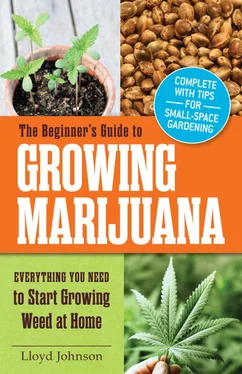Remove any darkened or bruised-looking plant tissue with a clean, sharp knife or pruning shears. Warm the beeswax in your hands to soften, and make a little plug. The warmed wax will be pliable and easy to shape. Smooth the top into a little cap so that all cut plant tissue is covered with wax. Some growers use chewing gum for the same purpose, but beeswax, due to its purity and waterproof properties, is preferred. Be sure to thoroughly clean your knife or shears in between cuts. Otherwise, you could be spreading what you are trying to prevent. Dip shears in a solution of one part bleach to four parts water.
Keep It Simple
A hygrometer that measures humidity is a must for the indoor grower. These frequently come paired with a thermometer, and provide digital readings on both temperature and humidity levels in the greenhouse or grow room. Indoor growers have the advantage of control: They can increase venting and air circulation to reduce humidity levels below 50 percent. Keeping the grow room at a lower humidity will have significant effect in inhibiting mold activity.
Outdoor growers must rely on existing weather and humidity conditions over which they have no control. Initially planting for good air circulation and constant monitoring of the crop for beginning outbreaks will go a long way in determining how much of your harvest can or will be damaged by mold. Bushier plants, and very thick, dense colas need to be gently inspected on a daily, and preferably twice daily, basis. Part the branches (be gentle to avoid breaking) and examine the inner parts of the plant; the center of dense vegetative growth receives the least air circulation.
Once you spot botrytis, you must react immediately. If you have outdoor plants, and they are near finish, remove any infected parts, bag in plastic, and then harvest the plant. Shower and change your clothes after handling infected plants; never go directly from handling botrytis to a clean plant, or you will spread the spores.
Keep It Simple
Certain types of cannabis will be more susceptible to mold, so each plant must be assessed individually if you are trying for more “finish.” It is better to harvest a little early than to lose an entire crop by waiting for an ideal moment that may not come.
Powdery Mildew and Downy Mildew
Both these mildews present in a similar manner, and the treatments are virtually the same. Affected leaves typically display blotchy spots in yellow or bronze and an overlying white, powdery fungal growth. These mildews are favored by high humidity but not necessarily free water on leaves. Warm temperatures and shady conditions encourage the fungus to grow and spread. Luckily, the spores and mycelium (vegetative part of the fungus) are sensitive to extreme heat and direct sunlight.
The optimum temperature for infection is between 68°F and 77°F, and relative humidity between 40 and 100 percent is sufficient for the spores to germinate. Low, diffuse light also seems to favor powdery mildew development.
In general, healthy, vigorous leaves and stems are less prone to infection. Plants under nutritional stress, in most cases, will develop mildews much sooner than plants the same age grown under a good nutritional program.
Outdoors, make sure plants are not crowded and are in full sunlight and a well-drained area. Indoors, use dehumidifiers and maintain good air circulation and ventilation. Ideally, always water your crop in the morning.
Mildew Prevention
Sulfur is highly effective against powdery mildew if used in a protective program with a minimum of seven to fourteen days between applications. Garlic naturally contains high levels of sulfur, and a few cloves crushed in water can be used to make a homemade spray.
Another organic option is to spray once a week with a solution of 1 tablespoon baking soda, 1 gallon of water (alkaline water with a pH of just below 8 is best), and a few drops of liquid soap to make the solution stick. Do not spray more often than once per week, as added frequency may add too much sodium, something your plants will resent. Baking soda increases the surface pH, making it more alkaline and unsuitable for the growth of mildew spores. Spray the undersides of leaves as well as the upper surfaces when using any sprays.
You can also use neem oil (available at garden stores), which is an organic solution for both molds and mites. Always use sparingly and follow directions; more is not always better and can be harmful.
Pythium Wilt
Damp-off, in which the little taproot becomes infected with a fungus parasite and rots, is primarily a problem with young seedlings. Start out with sterilized soil, avoid heavy watering, and provide adequate ventilation. If your previously vigorous little seed starts to suddenly lose momentum, there’s a good chance you are overwatering. Also be sure to check the humidity levels and for adequate air circulation.
Mold Prevention While Drying
While your harvested crop is hanging, drying, and curing, you must continue with close inspections on a twice-daily basis, especially if you brought the plants in due to onset of mold. Keep the humidity level as low as possible. If need be, purchase a dehumidifier and, of course, maintain constant gentle air circulation.
How to Check Drying Plants for Mold
Under good light, examine each plant from top to bottom. You will have already removed the fan leaves (see Chapter 13), so check each cola for any signs of mold. Remove any cola that shows mold and dispose of it carefully. Clean your tools and hands, and change clothes after handling moldy plant materials. This reduces the danger of spreading spores to clean plants.
At-risk plants (those with very dense, bushy colas) may need to be taken apart wet and dried in parts. The thicker colas may show no sign of mold until you expose the inner parts of the flowers. Some indica crosses can have massive central top colas that are very prone to mold. Botrytis in particular starts growing within the flower, so the onset is hard to spot.
Sometimes a plant needs to be removed from the drying area and broken up for salvage. It depends on how far gone the mold outbreak is, and the act of breaking apart the colas can spread spores. If you have thick, dense colas and see botrytis outbreaks all over the hanging plant, the odds are good that the insides of the colas are going to look scary. Do not hesitate to take all the colas apart and be ruthless in deciding what to dispose of. There is no “sort-of okay” area. If it is moldy, get rid of it!
Mold Prevention During Storage
Once your crop has finished hanging and drying, you will manicure the flowers for storage and store them for the longer curing process. Manicuring the flowers allows for close scrutiny of each individual flower for mold. Make certain you have good, bright light to work under; sometimes in dim light, a dusting of mold can look like trichomes. You do not want to store moldy flowers with clean ones.
Some growers use an interim step of storing the manicured flowers in brown paper grocery bags. The paper breathes well. The flowers should be gently stirred every one to two days. Or you can go straight to plastic zip-top bags or, preferably, glass jars with sealable tops (like Mason jars). Whether you use bags or glass, make certain to allow the cannabis to breathe by unsealing and resealing the container once per week. Smell the cannabis as you unseal it; you will notice the difference as soon as the plant material stops gassing.
Mark your calendar for breathing, and stay on schedule for the next six to eight weeks of curing; otherwise, you will ruin your harvest. Molds need moisture, so, as with any herb, store your cannabis in a cool, dark, dry place.
Читать дальше












